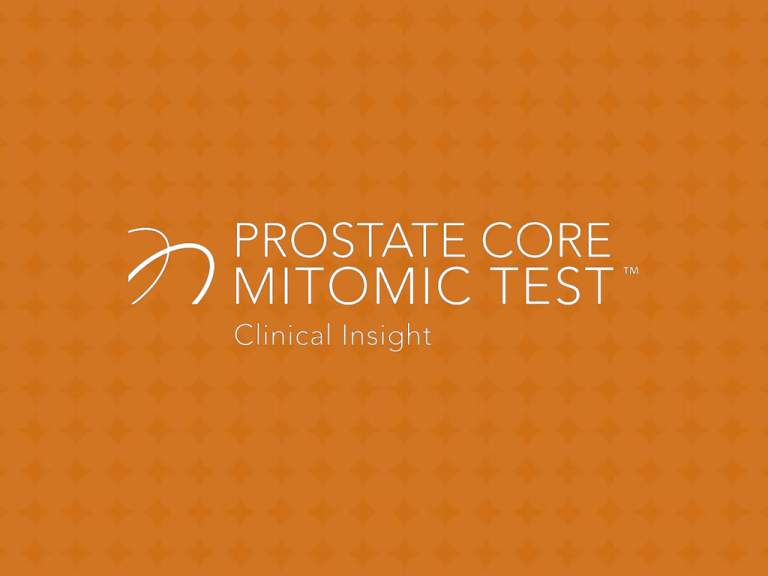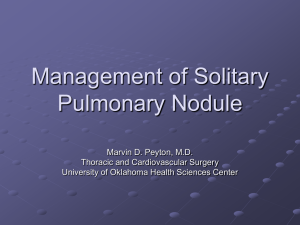
Biopsies
don’t tell
the whole
story.
False negatives are common
with initial and follow-up biopsies.
Each core represents
As many as
1/2000
30%
of a normal size
prostate (30 g).
of initial negatives
prove to be positive
on repeat biopsies.
Patients with false negatives are
managed in the same manner as
those with true negatives.
What if you could determine
the difference between a false
negative and a true negative?
Now you can with the
Prostate Core Mitomic Test.
Patient A
Negative PCMT Result
Age 62, persistently rising PSA, family history
Biopsy outcome
Request PCMT
Confirm a true negative with
92%
negative predictive value.
Patient B
Positive PCMT Result
Age 62, persistently rising PSA, family history
Biopsy outcome
Request PCMT
Identify patients at high risk for
undiagnosed prostate cancer with
85%
sensitivity.
Confidently stratify
your patients.
Negative PCMT result
Positive PCMT result
• Be more confident in
negative results.
• Detect undiagnosed
prostate cancer early.
• Provide peace of mind
to patients.
• Manage patient based on
positive PCMT result and
additional risk factors.
• Avoid causing patients added
pain, anxiety, and risk from
unnecessary, extra biopsies.
• Tailor patient management
for improved patient care.
Patient Selection
Clinical Response
Positive biopsy
outcome (30%)
PCMT negative outcome
PSA > 4.0 ng/ml
PSADT < 3
months
PSAV > 0.4
ng/ml/year
Negative biopsy
outcome (70%)
Patient currently at low risk of
undiagnosed prostate cancer.
Defer repeat biopsy and
routine screening 12 to 14
months.
Life Expectancy >
10 years
ASAP
HGPIN
Family History
African American
PCMT positive outcome
Patient is at high risk for
undiagnosed prostate cancer.
A repeat biopsy is
recommended with presence
of additional risk factors.
Tumor field effect
Tumor field effect
• Identifies a large-scale deletion in mitochondrial DNA that indicates
cellular change associated with undiagnosed prostate cancer.
• Detects presence of malignant cells in normal appearing tissue
across an extended area.
Why mitochondrial DNA?
The Prostate Core Mitomic Test detects largescale mtDNA deletion to discriminate between
benign and malignant prostate tissue.
Why mitochondrial DNA (mtDNA)?
• Mass copy rate allows for the most extensive field effect possible.
• Mutations associated with prostate cancer appear
in tumors and normal tissue.
• High susceptibility to damage enables unprecedented
early disease detection.
Key Data Review
Powerful differentiator of malignant and nonmalignant prostate tissue (p<0.0001)
Demographics
Patients
183
Total biopsy
cores
296
Age
67.05
• Deletion accurately discriminates between biopsies having prostate cancer
and those without (AUC 0.83)
• Non-malignant pathologies (HGPIN, atrophy, etc) do not confound this
discriminatory power.*
Maki J, et al. Mitochondrial Genome Deletion Aids in the Identification of False- and True-Negative Prostate Needle Core Biopsy
Specimens. American Journal of Clinical Pathology. 2008; 129:57-66.
Accurate predictor of repeat biopsy outcomes
Demographics
Patients
101
Total biopsy
cores
595
Age
60.64
PSA
7.09
ng/ml
Interval
between
biopsy
Up to 14
months
• Identifies men who do not require biopsy with a high degree of certainty
(SE 85%, SP 54%; NPV 92%; false negative rate 15%)
Robinson K, Creed J, Reguly B, Powell C, Wittock R, Klein D, et al. Accurate prediction of repeat prostate biopsy outcomes by a
mitochondrial DNA deletion assay. Prostate cancer and prostatic diseases. 2010;13(2):126-31
Disease specific with extensive tumor field
Method
Purpose
Result
19 radical
prostatectomies with
peripheral, unifocal
low volume tumor
Assess biomarker
frequency at
increasing distance
from tumor
All cores were positive for
biomarker which confirms the
great extent of the tumor field
26
cystoprostatecomies
– malignancy in
bladder but not in
prostate gland
Determine frequency
in
cystoprostatectomies
where malignancy was
not found in prostate
Low quantity of biomarker
supports specificity of biomarker
for prostate cancer negative
result on all specimens which
confirms biomarker is prostate
cancer specific
21 malignant
seminal vesicles
from malignant
prostatectomies
Determine frequency
in malignant seminal
vesicles taken during
prostatectomy
Low volume of biomarker
supports tissue specificity for
prostate cancer
21 benign seminal
vesicles from
malignant
prostatectomies
Determine frequency
in benign seminal
vesicles taken during
prostatectomy
Low volume of biomarker
supports tissue specificity for
prostate cancer
Mills et al. Large-Scale 3.4kb Mitochondrial Genome Deletion is Significantly Associated with a Prostate Cancer Field Effect. Poster
presented as part of the American Urological Association Annual Meeting, San Diego, CA, May 4-8, 2013. Journal of Urology, Vol.
189, No. 4S, Supplement e604, May 2013.
Parr RL, Jakupciak JP, Reguly B, and Dakubo GD. 3.4kb Mitochondrial Genome
Deletion Serves as a Surrogate Predictive Biomarker for Prostate Cancer in
Histopathologically Benign Biopsy Cores. Canadian Urological Association
Journal. 2010.
Demographics
Case 2
Patients
4
Age
65
Total biopsy
2-4/patient
PSA
8.9 ng/ml
Initial negative
biopsy
Yes
Biopsy 1
Negative (9 cores)
Positive repeat
biopsy
Yes (3)
Biopsy 2
(7 months)
Negative (10 cores)
Predicted
malignant outcome
11, 21 and 31 months
in advance of RP
Biopsy 3
(1 year)
Positive for prostate cancer in LB / HGPIN in RB
Benign outcome
confirmed
60 months in advance
of follow up biopsy
RP (2 months)
Tumor involvement in both L&R lobes. Largest mass in
LM. Cores from LM in all 3 biopsies returned negative.
PCMT performed
on initial biopsy
Positive for biomarker 21 months in advance of RP.
Identified in LM.
Appendix
Published data
•
John Mills, Luis Martin, François Guimont, Brian Reguly, Andrew Harbottle, John Pedersen,
Jennifer Creed, Ryan Parr. Large-Scale 3.4kb Mitochondrial Genome Deletion is Significantly
Associated with a Prostate Cancer Field Effect. Poster presented as part of the American
Urological Association Annual Meeting, San Diego, CA, May 4-8, 2013. Abstract published in
Journal of Urology, Vol. 189, No. 4S, Supplement e604, May 2013.
•
Ryan Parr, John Mills, Andrew Harbottle, Jennifer Creed, Gregory Crewdson, Brian Reguly,
Francois Guimont. Mitochondria, Prostate Cancer and Biopsy Sampling Error. Discovery
Medicine, Volume 15, Number 83, April 2013.
•
Parr and Martin: Mitochondrial and nuclear genomics and the emergence of personalized
medicine. Human Genomics 2012 6:3.
•
Kent Froberg, Laurence Klotz, Kerry Robinson, Jennifer Creed, Brian Reguly, Cortney Powell,
Daniel Klein, Andrea Maggrah, Roy Wittock, Ryan Parr. Large-scale mitochondrial genome
deletion as an aid for negative prostate biopsy uncertainty. Poster presented as a part of the
American Urological Association Annual Meeting, Washington, D.C., May 14-19, 2011. Abstract
published in The Journal of Urology, Vol. 185 No. 4S, e 764, Supplement, May 2011.
•
Ryan Parr, Jennifer Creed, Brian Reguly, Cortney Powell, Roy Wittock, Daniel Klein, Andrea
Maggrah, Kerry Robinson* Large-scale mitochondrial genome deletion as an aid for negative
prostate biopsy uncertainty. Poster presented as part of the Society of Urologic Oncology Annual
Meeting, Bethesda, MD, Dec. 8-10, 2010.
Published data
•
•
•
•
•
•
•
Parr RL, Jakupciak JP, Reguly B, and Dakubo GD. 3.4kb “Mitochondrial Genome Deletion Serves
as a Surrogate Predictive Biomarker for Prostate Cancer in Histopathologically Benign Biopsy
Cores.” Canadian Urological Association Journal. 2010.
Robinson K, Creed J, Reguly B, Powell C, Wittock R, Klein D, et al. Accurate prediction of repeat
prostate biopsy outcomes by a mitochondrial DNA deletion assay. Prostate cancer and prostatic
diseases. 2010;13(2):126-31. Epub 2010/01/20.
Parr RL, Jakupciak JP, Birch-Machin MA, Dakubo GD. The Mitochondrial Genome: A Biosensor for
Early Cancer Detection? Expert Opin Med Diagn. 2007;1(2):169-82.
Maki J, Robinson K, Reguly B, Alexander J, Wittock R, Aguirre A, et al. Mitochondrial genome
deletion aids in the identification of false- and true-negative prostate needle core biopsy
specimens. American journal of clinical pathology. 2008;129(1):57-66. Epub 2007/12/20.
Dakubo GD, Jakupciak JP, Birch-Machin MA, Parr RL. Clinical Implications and Utility of Field
Cancerization. Cancer Cell International. 2007;7(2).
Parr RL, Dakubo GD, Crandall KA, Maki J, Reguly B, Aguirre A, et al. Somatic mitochondrial DNA
mutations in prostate cancer and normal appearing adjacent glands in comparison to age-matched
prostate samples without malignant histology. The Journal of molecular diagnostics : JMD.
2006;8(3):312-9. Epub 2006/07/11.
Parr RLM, J.; Reguly, B.; Dakubo, G.D.; Aguirre, A.; Wittock, R.; Robinson, K.;
Jakupciak,J.P.;Thayer, R.E. The pseudo-mitochondrial genome influences mistakes in
heteroplasmy interpretation. BMC Genomics. 2006;21(7).
Thank you
Prostate Core Mitomic Test or one or more of its components was developed and its performance characteristics determined by Mitomics. It has not been approved by the Food and Drug Administrative
(FDA). Mitomics has determined that such approval is not necessary. This test is used for clinical purposes. It should not be regarded as investigational or for research purposes. Mitomics is regulated
under the Clinical Laboratory Improvement Act of 1988 as qualified to perform high-complexity clinical testing.
Prostate Core Mitomic Test, Mitomics, Mitomic Technology, Now You Can Know and Empowering Clinical Insight are trademarks of Mitomics Inc.
© 2013 Mitomics Inc. All rights reserved.







